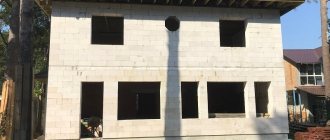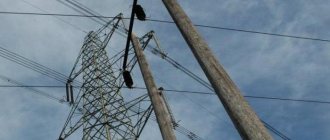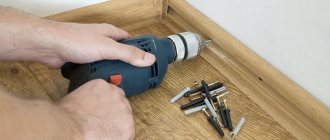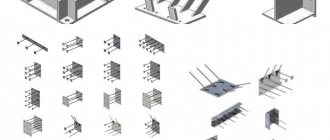- 1 Definition
- 2 Where are they used?
- 3 Advantages and disadvantages
- 4 Types
- 5 Production technology
- 6 Installation, repair and disposal of sleepers
- 7 Conclusion
During the existence of railways, supports for sleepers were made from various materials. There were stone ones, but stone is difficult to process, quickly cracks and becomes unusable. Durable wooden sleepers are tarred to protect against the negative effects of weather conditions. But after a while they also demanded either replacement or repair of the railway tracks. Today, reinforced concrete structures are rightfully considered the material of the future for the manufacture of supports for sleepers and foundations for buildings and structures. A foundation made of reinforced concrete sleepers is used for buildings of all possible complexity and number of storeys on any type of soil. However, it is worth considering that this product weighs a lot.
Definition
Reinforced concrete sleepers have the form of a rail support, the manufacture of which will require beams with varying sizes and cross-sectional shapes. Concrete rail supports are reinforced with steel wire, the diameter of which depends on the modification. When working with reinforced concrete sleepers, the following requirements are imposed on their production technology:
- preparing concrete mortar requires a uniform consistency;
- for the necessary transmission of stress, the material must have appropriate strength;
- When manufacturing products, they adhere to the exact dimensions and shapes that are important for reinforced concrete sleepers at the junction with the rails.
Return to contents
Technical requirements for wooden sleepers
Sleepers must fully comply with GOST requirements. It should be added that the uncut sides of the sleepers must be completely cleared of bark. Knots are cut flush with the surface.
The manufacturer must treat the sleepers with oil-based protective agents. For storage, sleepers must be stacked in dry warehouses.
The quality of used sleepers must be regularly monitored. For this purpose, detours are provided. If any defects are found, they are immediately eliminated.
Sleeper means "support" in Dutch. Sleepers appeared in Russia in 1834, but to this day their era has not yet ended.
Where are they used?
Nowadays, everyone wants to save money - used sleepers provide this opportunity when building your own home.
Reinforced concrete sleepers are used in the construction of foundations and railway tracks. Due to different natural operating conditions and varied mechanical loads on products, increased requirements are adhered to in the manufacture of reinforced concrete supports. This will increase the service life, which under favorable conditions of use will reach sixty years. Posts made using prestressed concrete outshine common wood posts everywhere due to their strength, durability and speed of installation.
Return to contents
Advantages and disadvantages
Reinforced concrete sleepers have the following advantages:
- long service life;
- sufficient resistance to the negative effects of environmental factors;
- no possibility of rotting during operation;
- resistance to various mechanical loads;
- low price category;
- installation and installation do not require large physical costs;
- do not require large maintenance costs during operation;
- Due to the fact that the width and length of the product are perfectly even, convenient transportation and unloading is ensured.
Reinforced concrete sleepers have the following disadvantages:
- The need for periodic inspection of railway tracks due to fatigue failure of a structure made of concrete.
- The sleeper weighs 0.27 tons, which means that manual installation of the products is impossible. Thus, due to the heavy weight, there is a need for specialized equipment. Concrete structures, unlike wood products, which weigh less, are mounted with special mechanisms - sleeper layers.
- The need to use elastic pads that reduce the rigidity of the product.
- Reinforced concrete sleepers have high electrical conductivity, which requires the use of insulation.
Return to contents
Application of reinforced concrete sleepers, technical characteristics, production
› Concrete products › Lintels
11.04.2019
Paying attention to the history of railways, you can see that there were several types of supports placed under the rails: stone slabs, wooden supports. Later, reinforced concrete sleepers became a reliable solution.
Reinforced concrete sleepers
Stone supports were difficult to process and cracks quickly appeared on them. Wooden sleepers were pre-tarred to protect them from negative atmospheric influences. However, after a short period of time they needed replacement.
A reinforced concrete sleeper is a beam having a variable cross-section. They are equipped with platforms for installing rails and have holes for connecting bolts for rail and sleeper fastenings. In the manufacture of products, pre-tensioning of reinforcement is used.
In the case of using prestressed material, it becomes possible to use smaller products, which leads to savings on concrete and reinforcement, transportation costs, and simplified installation.
Factories for the production of reinforced concrete products are located both in Moscow and in other cities of Russia. Reinforced concrete supports are in demand everywhere, and the demand for them is constantly growing.
Definition
Reinforced concrete sleepers are a rail support in the form of a beam. They are laid on a ballast layer so that the relative position of the rail threads remains unchanged.
Where are they used?
Reinforced concrete sleepers are often used in the process of constructing continuous railway tracks. In these cases, the distance between the rail joints is greater than the standard (25 m), which ensures a higher speed of railway transport and reduces operating costs.
Advantages and disadvantages
The advantages of concrete sleepers include:
- long operational period (in case of favorable conditions reaches 60 years);
- high rates of resistance to the influence of negative factors from the external environment;
- ability to withstand high mechanical loads;
- relatively low cost;
- no rotting or corrosion;
- high level of resistance to movement;
- Possibility of installation regardless of workload level;
- insignificant financial expenses for operational maintenance;
- no great physical effort is required during installation and installation;
- ease of transportation and unloading due to the same width and length of the structure;
- Possibility of dismantling and reuse.
Despite numerous advantages, such products have disadvantages:
- the need to regularly inspect railway tracks due to fatigue failure occurring in concrete sleepers;
- the weight of a reinforced concrete sleeper is 0.27 tons, so the products can only be installed using specialized equipment;
- to reduce rigidity, special elastic pads are required;
- relatively high cost of new products;
- insulation is necessary, since such sleepers are highly electrically conductive.
Types
Taking into account the length, width of products, resistance to cracking, the following types exist:
- 1st grade sleepers;
- sleepers of 2 grades (less stringent requirements are imposed on geometric dimensions, the degree of resistance to cracking is low).
Based on the type of rail fastening, products are divided into types:
- Ш-1 (separate clamp-and-bolt connection, attached to the support with a bolt and gasket);
- Ш-2 (indivisible mount);
- Sh-3 (similar to Sh-2 supports, differ in the method of fastening).
Reinforced concrete products differ in class, type of reinforcement used, and the presence of electrical insulation (non-insulated or insulated). The requirements for the parameters of reinforced concrete sleepers are strict.
Depending on the features of use and installation, reinforced concrete rail supports are:
- pavements (laid on bridges);
- shuttle (for bridges and tunnels);
- intended for curved sections (with a radius of less than 350°);
- transformer (differ in rectangular cross-section along the length);
- for turnouts;
- for children's railways (wheel width 750 mm, rails R-43);
- half sleepers (for tracks along which overhead cranes move).
Production technology
Production technologies ensure the performance properties of products. They must meet the following requirements:
- the concrete solution must have a uniform consistency;
- the required strength of the material for the required transfer of stress force;
- compliance with sizes and shapes that are of great importance when connecting sleepers and rails.
In the production of products, M500 concrete with a frost resistance index of at least F200 is used. Filler - crushed stone or gravel with a fraction size from 5 to 20 mm.
4 most common technologies that meet the requirements:
- Carousel type with delayed mold removal. The concrete mixture poured into the molds is compacted, and the product is removed only after it reaches high strength values. During production, special molds are used that can hold up to 6 units. With the help of special tension mechanisms, the tension of the reinforcement bars is ensured (later, it is transmitted to the concrete, creating the best adhesion to it).
- Linear type. A conveyor with several forms located one after another is used (its length reaches 100 m). At the ends of the molds there are special devices that transfer prestress to the reinforcement bars. When the composition dries, force is transferred to the concrete.
- Removal of the mold followed by tension. This technological process involves placing forms into templates that determine the position of reinforcement bars. After this, the concrete mixture is poured and compacted. During hardening, metal pins are inserted into the concrete and subjected to mechanical pressure. After the allotted time, the form is dismantled and the templates are removed. This method ensures a continuous process, requiring a small number of molds to obtain the desired result.
- Dismantling with prestressing. The technology is similar to the previous method, the difference lies in the transmission of tensile force (frames are used instead of pins).
Types
Reinforced concrete sleepers are divided into the following types, which depend on resistance to possible cracks, quality and the exact width, length and other dimensions of the product:
- First class support.
- Second grade support. It is characterized by a low degree of resistance to cracks, geometric dimensions do not require high requirements.
Depending on the type of rail fastening, there are the following types:
- Ш-1, with a separate type clamp-bolt connection, which is fixed to the support using a gasket and a bolt.
- Sh-2 of an inseparable type of fastening.
- Sh-3 are similar to Sh-2 supports, but differ in the method of fastening.
Reinforced concrete sleepers vary in class, the presence of electrical insulation and the type of reinforcement used. Reinforced concrete sleepers have differences in electrical insulation parameters:
- isolated;
- non-insulated, without insulating liners.
Return to contents
Parameters of wooden sleepers
The GOST 78-2004 standard, in force since 2006, is used in the countries of the customs union and clearly regulates the parameters and class of wooden sleepers. There are 3 classes in total, the first is the highest. Dimensions are set depending on the class.
So, for class 1, the thickness is set to 1.8 m, the height of the sides (sawed) is 1.5 m, the width of the side at the top is 1.8 m and 2.1 m, at the bottom - 2.5 m. For sleepers of class 3: thickness 1, 5 m, height of the sides (sawed) 1.05 m, width of the upper side 1.4 m and 1.9 m, bottom - 2.5 m. The total length of the three classes is 275 cm. For these parameters, wood moisture content of up to 22% is required . If the humidity level is higher than normal, allowances for drying are required (GOST 6782.1-75 and GOST 6782.2-75).
A prerequisite is antiseptic impregnation of the sleeper before laying and marking on the end.
Size, length
Standard length 275 cm (+/- 2 cm). For tracks with high freight traffic, the length can be increased to 280 cm. For tracks with different gauges, the length can be 3 m.
Weight
The weight of coniferous wood sleepers ranges from 80 to 85 kg.
Production technology
Regardless of the area of use, reinforced concrete supports are made with the same strength and performance properties. There are four types of support manufacturing technology:
- Carousel type followed by mold removal. It consists of preparing the mixture and pouring it into molds, where it is further compacted. Remove the supports from the container after the solution has completely hardened and reached its maximum strength. For manufacturing, cassette structures are used, which accommodate six supports. To achieve the required adhesion and provide prestress, reinforcement is used, with the help of which the stress is transferred to the surface of the concrete. Upon completion of the product, the mold is removed and started for the next production.
- Linear. This type of manufacturing a reinforced concrete support involves a linear technology, which requires a conveyor on which the forms are placed in a certain sequence. The length of the installed forms reaches one hundred meters. The sides of the container are covered with specially designed devices, which are also capable of transmitting voltage to the reinforcement. As the mortar sets, stress is transferred to the surface of the concrete.
- Dismantling of forms with further stress. This type of manufacturing of reinforced concrete supports requires the installation of templates, with the help of which the location of steel reinforcement is determined. The containers are filled with concrete mortar and compacted. While the solution is setting, the pins are immersed in it. After some time, the mold and template are removed.
- Dismantling forms with prestressing is the same technology as when dismantling forms with further tension, only instead of pins, frames are used that provide a tension force in the product.
Return to contents
Types of Wood Sleepers
Sleepers are divided into three types depending on the paths where they will be laid:
- For main (main tracks) (classes 1 and 2) and tracks with high freight traffic.
- For main tracks (classes 3 and 4) and marshalling tracks with high traffic intensity.
- For tracks of class 5, shunting, with low traffic intensity.
According to the cross section (its shape), sleepers are divided into:
- Edged - 4 sides are sawn - laid in the main tracks.
- Semi-edged - 3 sides are sawed through, the remaining two may not be sawed completely - used in tracks at stations and non-public tracks.
- Unedged - 2 opposite sides are sawn through - for non-public routes with low freight traffic.
It is permissible to use previously used sleepers removed during repair or construction work. Such sleepers are divided into categories:
- Category 1 – sleepers with wear up to 5 mm, without splitting through, without rot and with fastening hole sizes up to 24 mm. Allowed to be used on tracks of 1, 2 and 3 classes, as well as sorting.
- Category 2 - wear from 30 to 50 mm, cracks, end-to-end splits, mounting holes up to 4 cm are allowed. In addition, the length is allowed to be reduced to 250 cm after removing the rotten part of the end ends. Can be used on routes of 3 and 4 classes.
- Category 3 – this includes sleepers that are not included in the first two categories according to their characteristics, as well as composite sleepers that have the same type of material. Can only be used on class 5 tracks.
Installation, repair and disposal of sleepers
The installation of railway tracks has the following features:
- Reinforced concrete supports and rails are installed on a pre-prepared surface, which consists of soil, sand and crushed stone. To preserve the sleepers during operation and the passage of trains over them, it is important to preserve the top layer of earth by installing sand strips.
- A reinforced concrete support weighs a lot, and an ordinary worker cannot lift such a weight of the structure; installation is carried out using mechanized equipment. This approach reduces the use of physical force and reduces the cost of installing products. The mechanized complex also reduces the time for laying the railway.
- To use reinforced concrete sleepers for fifty years, it is important to diagnose the tracks, which will identify deformations and breakdowns. The fastening elements are checked to ensure that there is no breakage, as this could lead to disruption of the fixation of the lining, which makes sounds as the train passes along the tracks.
- Failure to timely detect the failure of fasteners leads to the appearance of cracks and partial or complete breakage of the sleeper.
- When the service life of the product has expired or the reinforced concrete support has become unusable due to possible destruction, the sleeper is disposed of. Disposal occurs with a jaw crusher, with the help of which the product is crushed to the size of crushed stone of a small fraction or medium fraction. The recycled products are subsequently used to fill holes.
Repairing reinforced concrete sleepers involves identifying and eliminating defects and damage. Seal chips, potholes, sinkholes and cracks. When a breakdown is repaired, train traffic does not stop; the workplace is fenced off with a special signal sign. Major repairs are carried out between repairs, where sleepers do not need to be changed, repairs are carried out using track machine stations according to prepared individual projects and calculations. Repair of reinforced concrete supports is divided into:
- capital;
- average;
- lifting;
- reconstruction.
By type of top installation: laying on new crushed stone or on old crushed stone. To enhance the power and durability of tracks, in the process of repairing damaged parts, under-rail bases of various designs are used.
Return to contents











